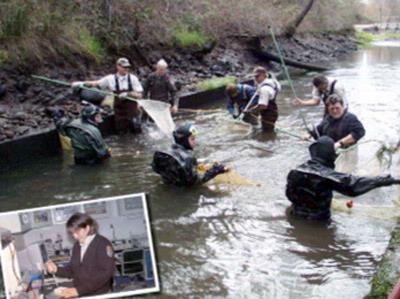
Innovative Solutions at Leavenworth Fisheries Complex
Tuesday, August 18, 2015
 |
The U.S. Fish and Wildlife Service are trying new techniques to combat challenges presented by unprecedented high temperatures and low water flow. “We got into an emergency situation when our fish got sick,” said Dave Irving, manager of the Leavenworth Fisheries Complex, describing a rescue operation that began July 31 to save the hatchery’s fingerling Chinook salmon. “We’ve got to do something to solve the water problem.” Working with multiple partners, Leavenworth National Fish Hatchery launched an experimental project to recharge groundwater wells. The plan was to pump water exiting the hatchery up to a dry channel, where water could percolate into hatchery wells. Initially conceived by hatchery staff and supported by the Icicle Creek Workgroup, the pumpback is an innovative way to deliver cool, clean water to the fish. The Workgroup is comprised of a diverse set of stakeholders representing local, state, and federal agencies, tribes, irrigation and agricultural interests, and environmental organizations which co-convened to find collaborative solutions for water management within the Icicle Creek Watershed. The hatchery draws surface water from Icicle Creek and groundwater from wells. As surface water temperatures increase in summer, cooler groundwater is mixed in; but because of sustained high temperatures and low water levels, there is not enough groundwater to keep the fingerling salmon cool enough for good health. Water leaves the hatchery via the fish ladder. In the lower section of the fish ladder, a pump was installed on August 3 to carry the effluent water up into the hatchery channel. The channel was created in 1939 to help control water flow in Icicle Creek and is typically dry in summer. When water is present, it percolates down from the channel, filtered and cooled by the soil, and re-enters the groundwater. Contractor Belsaas and Smith installed a temporary pump to bring hatchery effluent water into the channel, and well levels began to respond right away. Installation of a bladder dam on August 18 will form a deeper reservoir and increase downward pressure, helping more water fill the wells. The water also percolates back out through groundwater seeps into Icicle Creek, providing healthier water for healthier fish. The hatchery plans to continue the experiment, monitoring and collecting data through the end of September. “This is a proof-of-concept project,” says Steve Croci, the Complex’s deputy manager. If the pumpback project continues to deliver promising results, it could become a permanent solution for the hatchery.